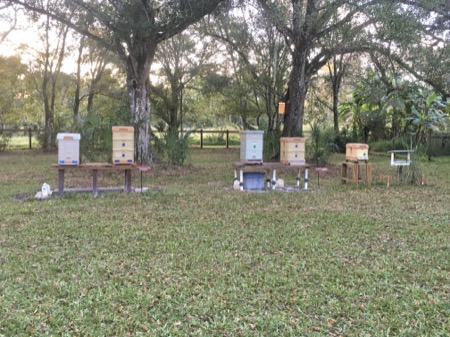 My 3 Apimaye hives, etc. |
Welcome to www.PaulMikkelsen.com/Personal/Bees Beekeeping Resources for Honey Bees Hopefully helpful... surely not comprehensive. Contact: |
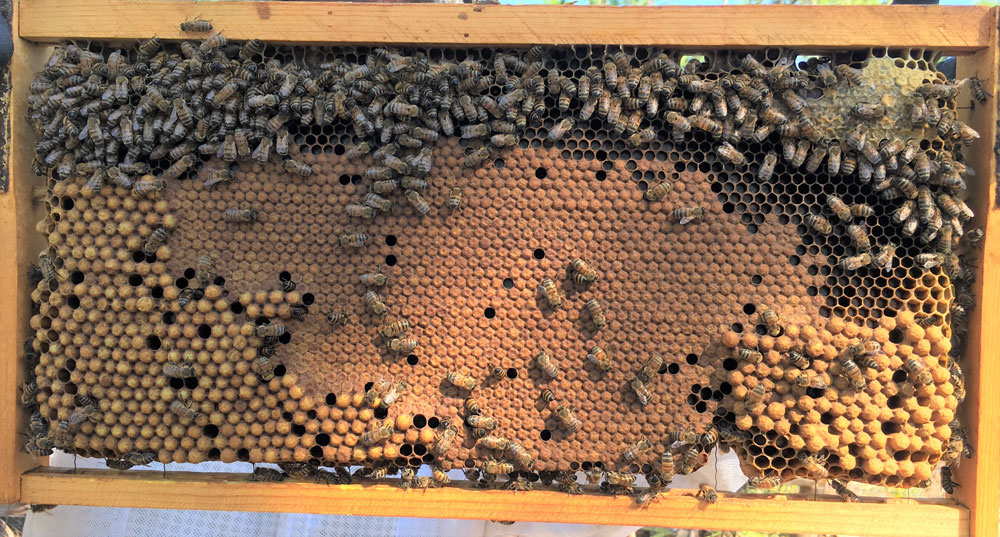 Honey, drone & worker brood |
| Web Pages: |
|
|
Terminology and Acronyms
| Of particular note: Honey Bee is two words, as confirmed by Wikipedia and
by Caron & Connor on pg. 21 of their 2018 reprint edition (originally 1999) of
Honey Bee Biology and Beekeeping, which states "By convention of the Entomological Society of America, an insect's common name is two words if the insect is classified in a taxonomic grouping to which the name applies." [e.g., bumble bee, house fly] "Frequently, honey bee is hyphenated when used as a compound modifier placed before the word it modifies (e.g., honey-bee physiology)." A "pet peeve" of mine: The misuse of the terms hatch and emerge. Another distinction (that I like to make) is between hive (or, beehive) and colony. Another odd term is "swarm trap", the box or other type of container used to attract a swarm of bees doesn't actually trap them... it attracts them! The term "hair" is totally incorrect for honey bees, but is often used. The term "alcohol wash" is proper for one of the common tests for the Varroa destructor mite. You'll see the term "alcohol shake" used incorrectly. Per Randy Oliver (Two bees in a Pod podcast, episode 6: If Your Goal is to Keep Your Bees Alive.), a high percentage alcohol should be used, and the bees immersed in the alcohol should be swirled, not shaken; shaking (with the alcohol test) serves to move mites back onto the bees as much as it does to knock the mites off of the bees. You'll see the terms alcohol wash and sugar shake used properly on Randy's web page: Sick Bees Part 11: Parasite Monitoring. |
 August 2024! August 2024!supersedure or supercedure? Which is correct? ...I think with the "s" probably NOT in any of the above terminology references adventive - On page 770 of an article on "Immigrant Bees that Colonized North America" by Rusty Burlew (American Bee Journal 159(7):769-773), she states: "Species that move into an area are known as adventive, but the word has several shades of meaning. Some scientists include deliberately introduced species, but others include only those that arrived on their own or by accident. Some writers use adventive to describe species that are not self-sustaining, but need an occasional population boost from their homeland. If an adventive species becomes self-sustaining in its new geographic area, it is then said to be naturalized. Other words with variable meanings such as acclimatized, immigrant, and invasive make the subject even more confusing." bald brood - developing larvae at a stage just before being capped, with their white heads exposed inside the top of their cells, showing a white-headed ("bald") appearance within the cell. bole or bee bole - A large hole or opening or cavity in a wall in which skep style beehives are kept. bull swarm - When a hive "decides" to swarm multiple times, the 2nd swarm is called the bull swarm (usually with a new queen). The 1st swarm is called the prime swarm (usually with the old queen), while subsequent swarms are called casts (e.g., 3rd cast, 4th cast, etc.). buzz pollination - The process employed by some native bees... NOT by honey bees... to obtain pollen from flowers by lighting on the flower, positioning itself, and shaking or vibrating to get the flower to release its pollen. carpet swarm - A swarm that has clustered on the ground. This does not happen often, but can happen when (for some reason) the queen has difficulty flying [maybe has a clipped wing?] and cannot get far from the hive and fails to get any altitude to a more appropriate swarm location. As always, the rest of the swarm will congregate around the (grounded) queen. 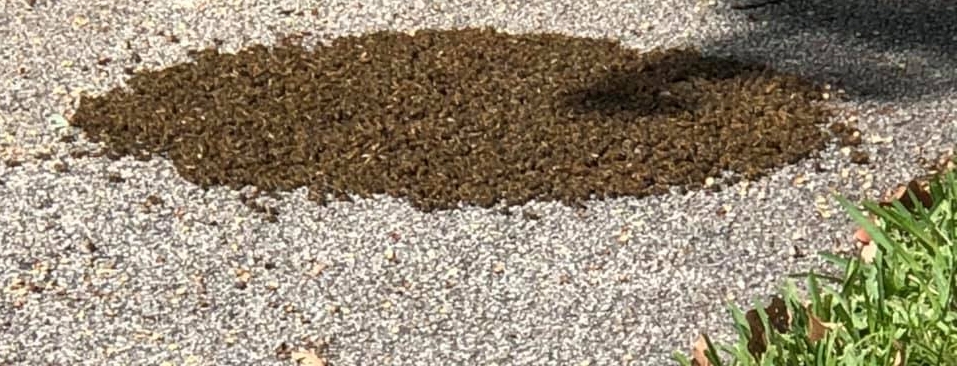 Photo © Nina Ferraro cast - the 3rd, 4th, etc swarm from a hive that swarms multiple times; e.g., 3rd cast, 4th cast, etc. The first swarm is called the prime swarm and the 2nd swarm is called the bull swarm. [do not confuse with "castes", the 3 types of honey bees in a colony: queen, workers, & drones] Cloake or Cloaking Board - Although Bush Bees provides one definition (aka FWOF, Floor With Out a Floor), the term also applies to a form-fitting, opaque, solid end board to establish the temporary end inside a horizontal hive; the board is moved further toward the hive end as more frames are added within. crud - "A general term given to a condition associated with bee brood. Colonies showing signs of the crud often have spotty patterns, uncapped brood cells that should be capped, dead or dying larvae, and/or pupae, brood "melting" in their cells (I will call this "melty larvae"), etc. Some people also call this "snot brood" or other interesting terms." per Jamie Ellis; April 2020 American Bee Journal 160(4):373. cuddle death - another term for "balling". This is a behaviour by many worker bees encompassing their queen in a ball ("cuddling") to kill her by raising her temperature to the point that it is lethal. This behavior may be initiated during supersedure to replace the queen, IF there are new queens to become available. This behaviour may also occur to kill predators in the hive, such as wasps. dead-out - A hive that is suddenly dead. The bees may all be dead in the hive (for various reasons) or may have absconded or there was a slime-out. dink - A weak or very weak hive. diutinus - another, more technical, name for "Winter Bee", recognized by some as a third female caste of honey bees: those capable of surviving an extended period of dormancy in the winter. For more, see: The Secret of Winter Bees vs Summer Bees drop-in-a-queen - A slang term for introducing a new queen to a hive; this process involves much more than simply "dropping" a new queen into a hive. heterosis - hybrid vigour; the increase in such characteristics as size, growth rate, fertility, and yield of a hybrid organism over those of its parents. Plant and animal breeders exploit heterosis by mating two different pure-bred lines that have certain desirable traits. honey ceiling - Refers to a storage predicament inside a honeybee hive. When a thick layer of capped honey is stored in the upper part of the frames in the top (or only) box of the brood nest. Honeybees often see this layer of capped honey as a barrier to any potential open space above it. The capped honey provides a “ceiling” that bees feel they cannot cross, even if an empty super box with drawn comb to store honey in is above them. [This definition from: Perfect Bee: Nectar Storage & the Honey Ceiling] hot hive - A hive in which the colony of bees are very aggressive and very defensive. This condition MAY be due to some African genetic influence; it MAY be temporary, brought on by rough handling by the beekeeper or simply the ambient environmental conditions. Do not confuse a "hot hive" with a hive of Africanized bees! humili - The hooks that secure the honey bee's fore and aft wings together to synchronize them for flight. polyandry - a pattern of mating in which a female animal (e.g., a queen honey bee) has more than one male mate. On her mating flight(s), the queen honey bee may mate with a dozen or more drones. polyethism - Functional specialization in different members of a colony of social insects, which leads to a division of labor within the colony. The various functions may be carried out by individuals of different morphology (caste polyethism) or of different ages (age polyethism or temporal polyethism). regicide - The killing of a king (in the narrow sense); the killing of any monarch (in the broad sense). In beekeeping, this term can be applied to the killing of a queen bee... either by predators, or by her own daughters (worker bees) or by another queen. seta (pl. setae) - is a biological term derived from the Latin word for "bristle". It refers to a number of different bristle-like or hair-like structures on living organisms. For Honey Bees, setae is the correct term for the "hair-like" or "furry" or "fuzzy" aspects of their exterior. True "hair" is a defining mammalian characteristic and is technically incorrect for honey bees. shimmering - the process of a colony of bees sending a "wave" across their open comb by synchronizing the flicking of their abdomens as a sequential defensive action. See YouTube video: Massive Bee Colony Buzzing In Sync To Scare Off Predators shook swarm - A method to control American Foulbrood (AFB), if you want to save the queen and worker bees from an AFB infected community. slime-out - the sudden death of a hive/colony due to an extreme infestation of small hive beetles (Aethina tumida) and their larvae, causing a massive dripping of honey stores which have become very slimey. Snelgrove Board - Also known as a double screen board, has several different uses but in swarm prevention works by having six separate notches that divide a colony into two, separated by a double screen. The brood, queen, and all queen cells are placed in the top, and the foragers continue to use the main entrance on the bottom. Over time, the foragers return to the colony that has no brood. The brood has no foragers, and swarming is abandoned. [see: Am. Bee J. 169(6):713] tremble dance - a honey bee dance [see pg. 694 in Am. Bee J. 159(6):687-698.] that is designed and intended to recruit more nectar receivers, in contrast to the waggle dance (discovered & described by Karl von Frisch) that is used to recruit more foragers. Note: the waggle dance is also used by scout bees reporting locations for a new hive. See YouTube videos: Honey bee tremble dance and Honeybee tremble dance?. undersuper - The process, when adding an additional super to a hive stack, of placing the new super underneath an existing super. Why? ...see this video: Colony Management Summer 2019 at about 16:00+ wheal - an area of the skin which is temporarily raised, typically reddened, and usually accompanied by itching; e.g., symptoms often experienced as the result of a bee sting. Winter Bee - See: diutinus. Connor, Andrew. 2018. BeeCabulary Essentials. Wicwass Press LLC, Kalamazoo, MI; 234pp. 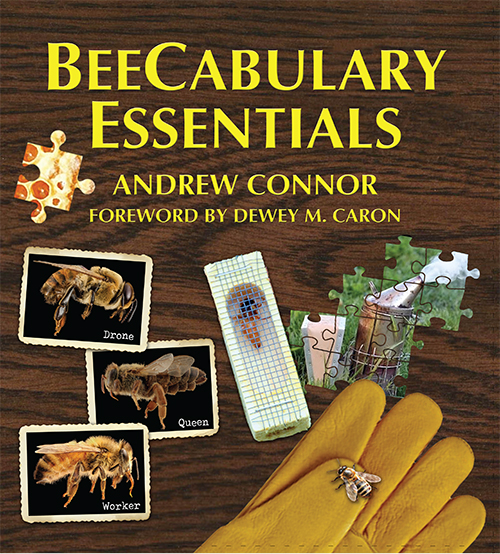
|
NOT in any of the above web pages AZ - Alberti-Žnideršič (inventor of the AZ Hive) DFM - Direct-Fed Microbials. See: DFMs are probiotics and Honeybee Probiotics EC - European Countries; used as a designation on honey labels to indicate that some contents are from European Countries (EC) or not (non-EC). 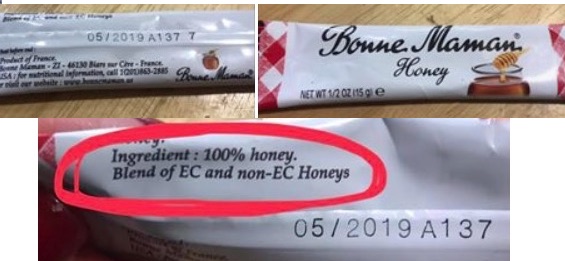 Photo source: modified Facebook post; photographer unknown. FOB - Frame Of Bees; "The number of Frame interspaces full Of adult Bees." This definition and acronym was used (coined?) by Randy Oliver in the July 2021 issue of American Bee Journal 161(7):764. IMN - International Mating Nuc system of queen rearing. Developed by Mel Disselkoen, the IMN system is the precursor of OTS queen rearing (see below). NMR - Nuclear Magnetic Resonance, a process employed to determine the adulteration and origin of honey. [see pg. 383 in: Phipps, R. 2019. International Honey Market. Am. Bee J. 159(4):383-389.] OTS - On The Spot; A term coined by Mel Disselkoen (See: his book, and his website). OTS is often used in connection with queen rearing. See: 7 Key Principles for Successful OTS ("On The Spot") Queen Rearing and Colony Increase QRC - Queen Right Colony; The status of a honey bee colony having a productive queen. |